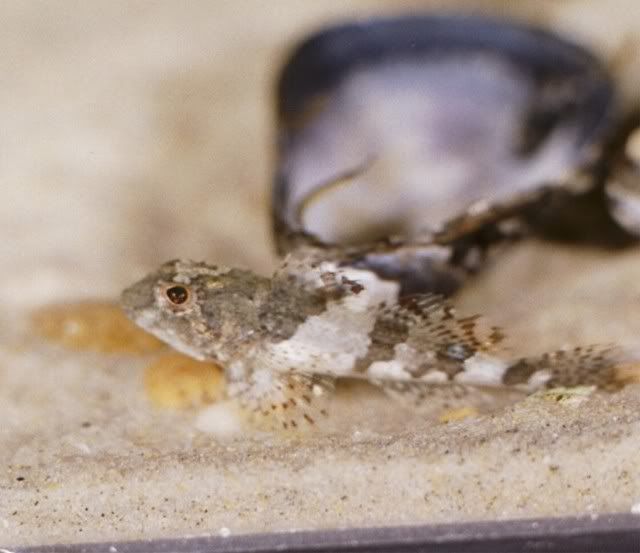Grubbies
#1
 Guest_Flounderfan992_*
Guest_Flounderfan992_*
Posted 09 August 2008 - 01:21 AM
#2
 Guest_mikez_*
Guest_mikez_*
Posted 10 August 2008 - 02:10 PM
I bet you could search the net all day and not find someone with experience with grubbies and gunnels [rock eels]. You found one here though, at the home of the ultimate native fish geeks.
Grubbies are awsome captives, very easy to keep and very undemanding. Room temps are OK. No chiller or heater required year round. The tank you describe would be fine.
There are two major drawbacks to keeping grubbies.
The first is the difficulty in distinquishing grubbies from juvenile longhorn or shorthorn sculpins. The later two grow to over a foot long - quickly. The size of the mouth on a foot long sculpin makes it a single specimen only tank fish. Any fish too big to be eaten by the sculpin would most likely eat the sculpin!
The second, and more important drawback is the hair trigger preditory response the grubby [and other sculpin] have. They can't control their reflexes when another fish triggers their feeding response. They will attack and try and eat fish much too big for them to swallow. This never works out well for the victim. If the victim is a fish which has spines, the grubby may be unable to spit it out and they both die.
If you do decide to keep one, start offering it pieces of fish on a broomstraw. Wiggling the piece of meat infront of the grubby should tempt it to eat. In a very short time you can just drop the food in and they will find it.
Rock gunnels [rock eels, conger eels, butter eels etc] are one of my all time favorite native marine species. They are however much more sensitive than most other cool water species. Disolved oxygen seems to be their biggest limiting factor. I have found them in Rhode Island tide pools which can reach > 80 F for short periods so temp is not directly the limiting factor. DO in those tide pools tend to be pretty high from wave action, temps not withstanding. On the other hand, I have had gunnels die in overcrowded collection buckets which never exceeded 65 F.
Nevertheless, if your 70 gallon is well aerated, and has plenty of rocky hiding places, they will do well with any but the most aggressive tankmates. I start them on wild [saltwater] mussels, clams and crabs. Once tame, they will take frozen brine and other commercial frozen meaty foods.
Overall, if you do your homework, I think you have conceived a very cool tank and one that I personally have proven to be viable.


#3
 Guest_GulfofMainer992_*
Guest_GulfofMainer992_*
Posted 10 August 2008 - 11:31 PM
this link says how to distinguish juvi shorthorns from the grubby
#4
 Guest_mikez_*
Guest_mikez_*
Posted 11 August 2008 - 10:21 AM
http://www.gma.org/f...alus_aeneus.htm
this link says how to distinguish juvi shorthorns from the grubby
I've seen that before [excellent reference source btw].
Just remember that ID keys can be tough when dealing with juveniles.
As a totally unscientific observation, while snorkling in the cooler water north of the Cape, I often spot large sculpins which are obviously not grubbies. On the other hand, while snorkling the shallows of RI I very rarely see large sculpins but plenty of small [grubby sized] ones. From that limited observation, I deduce grubbies are more southern while shorthorns like the cooler water.
Having said that, I did once collect a grubby from the New Meadows river, below the tide line, in Bath Maine.
Edited by mikez, 11 August 2008 - 10:23 AM.
#5
 Guest_daveneely_*
Guest_daveneely_*
Posted 11 August 2008 - 12:35 PM
juveniles aren't going to have different numbers of anal fin rays than adults; the 10-11 in grubby is easy to tell from the 13-14 in shorthorns of any size. You're probably right about differential temp tolerance (preference?), but grubby goes northward to at least northern NS and NF.
Dave
#6
 Guest_Flounderfan992_*
Guest_Flounderfan992_*
Posted 11 August 2008 - 12:58 PM
#7
 Guest_mikez_*
Guest_mikez_*
Posted 12 August 2008 - 08:15 AM
hey Mike,
juveniles aren't going to have different numbers of anal fin rays than adults; the 10-11 in grubby is easy to tell from the 13-14 in shorthorns of any size. You're probably right about differential temp tolerance (preference?), but grubby goes northward to at least northern NS and NF.
Dave
I'm sure you're right Dave.
I'm not that great at counting fin rays on 3 inch fish while holding on to a rock in the surf.
#8
 Guest_Flounderfan992_*
Guest_Flounderfan992_*
Posted 16 August 2008 - 05:30 PM
#9
 Guest_smilingfrog_*
Guest_smilingfrog_*
Posted 17 August 2008 - 03:51 PM
Maybe the saltwater ones are a little more skittish though, and I suppose it might not be the easiest method in heavy surf.
#10
 Guest_mikez_*
Guest_mikez_*
Posted 17 August 2008 - 06:45 PM
Those north shore tide pools can turn up some very cool cold water species. Two very cool ones are lumpfish and some super colorful nudebranch. Go out to the extreme furthest pools on a low moon tide and lift the big strands of kelp. Look carefully, the lumpfish will cling to the weed fronds and you'll miss them. Some day when I'm rich I'll buy a chiller and set up a cold water tide pool habitat.
#11
 Guest_critterguy_*
Guest_critterguy_*
Posted 03 September 2008 - 01:14 PM
0 user(s) are reading this topic
0 members, 0 guests, 0 anonymous users







